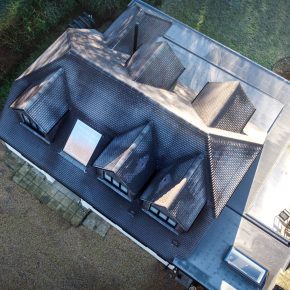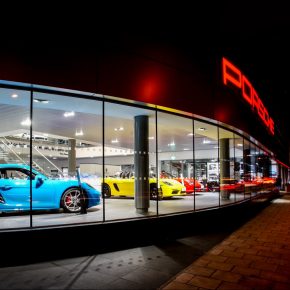
Stella Rooflight: Steel framed conservation rooflights and rust
Paul Trace from Stella Rooflight provides an insight into steel framed conservation rooflights and the issue of rust, while highlighting some of the important considerations in the specification process…
Often specified in both period and contemporary projects, a steel framed rooflight design normally offers a superior glass to frame ratio, when compared with modern bulky rooflights. This extra access to both natural light and ventilation is one of the reasons why steel frames remain a popular choice. In certain applications, such as Listed buildings, conservation areas or sensitive replacements, steel framed rooflights should be the only choice, as these offer the most faithful replica of an original Victorian design.
The saying goes that ‘beauty is only skin deep’, however, when choosing or specifying rooflights it is important that you look beyond appearance and take into consideration the longevity and maintenance requirements of the materials used.
While the appearance of a steel framed rooflight is second to none there is an inherent shortcoming in the use of steel, particularly when used in a roof, and that is the potential for it to rust. The most common steel used for rooflights is mild steel (sometimes referred to as carbon steel) and in their naked form these materials offer virtually no resistance against rusting and will begin to corrode from the moment it comes into contact with the atmosphere.

Aren’t all steel rooflights the same?
Mild steel (iron containing a small percentage of carbon, strong and tough but not readily tempered), also known as plain-carbon steel and low-carbon steel, is now the most common form of steel for conservation rooflights, because of its relatively low price and versatility.
Almost all rooflights are produced with some type of paint coating, which is designed to keep the main structure away from atmospheric conditions; in the case of mild/carbon steel rooflights this prevents them from rusting. It is worth noting that mild/carbon steel framed rooflights are totally dependent on the paint to stop the frames rusting and even the slightest damage during installation can signal the demise of your rooflight.
One of the ways to avoid the risk of rusting associated with steel framed rooflights is to specify a 316 marine grade stainless frame.
The most obvious difference between carbon steel and stainless steel is the ability to resist corrosion, with stainless steel (as the name implies) being the more corrosion resistant material. Both carbon steel and stainless steel contain iron, which oxidizes when exposed to the environment, creating rust. It is the presence of added chromium in stainless steel, which makes it more corrosion resistant than carbon steel.
Without wishing to overcomplicate the point, the chromium will attach itself to oxygen more readily than iron, but when the chromium attaches to the oxygen it creates a chromium oxide layer, which protects the rest of the material from degradation and corrosion. Carbon steel does not have enough chromium to form this chromium oxide layer, allowing oxygen to bond with the iron, which results in iron oxide, or rust. Therefore, if corrosion resistance is a key factor in your choice of specification, stainless steel has to be the way to go
Protective coatings
Steel framed rooflights will usually have a powder coating or wet spray paint finish. Unlike mild/carbon steel, which relies on the coating for complete protection, a 316 marine grade stainless steel rooflight mainly has the coating for aesthetic purposes.
Powder coat is a type of coating that is applied as a free-flowing, dry powder. Unlike most conventional liquid paints, which are applied via an evaporating solvent, powder coating is typically applied electrostatically and then cured under heat. Powder coating is mainly used for coating of metals and is designed to create a finish that is tougher than conventional paint.
Done correctly powder coating provides a high-quality finish, which gives metalwork a more durable layer than liquid paints can offer, while still providing an attractive appearance. Applied to the right environment criteria, powder coated rooflights are more resistant to diminished coating quality as a result of impact, moisture, ultraviolet light, and other extreme weather conditions.
C1 to C5
Powder coat applications should always be applied to a standard suitable for the location of the rooflight. The environment in which a rooflight is located is classified from C1 to C5 with the lower end of the scale (C1) for internal use in buildings with clean atmospheres, right up to marine coastal/industrial with aggressive atmosphere (C5).
The most common application for steel framed rooflights is to a C3 standard, which covers urban and industrial atmospheres with moderate sulphur dioxide pollution. While this should give a good standard of protection for most places in the UK there are a number of factors, which could affect the lifespan but are often overlooked.
It is easy to identify a property which is within 5km of the coast and specify the required marine coating, however if a property is located close to a road which is heavily gritted during the winter months this could potentially be as aggressive and corrosive to the powder coating as a property which is sited within a coastal environment.
Ultimately identifying the right classification is not always as straightforward as looking up a postcode and careful consideration should be given to any environmental factors which may impact on the lifespan of the protective coating. Choosing the right durability is a question of cost but if the system doesn’t last long enough, rectification could be expensive for the end user.
Paint coats are not magic coats!
Industrial coatings are no different to the paint on your car – they need cleaning and maintaining. Accumulated dirt may affect the design life of the system, and any mechanical damage almost certainly will. Therefore regular inspections should take place and minor damage must be touched up.
What many specifiers and end-users do not appreciate is that maintenance is not only required to keep up the aesthetic appearance, it is essential to prolong the life of the rooflight. From the moment the product is installed, the end-user is entirely responsible for providing that maintenance and failure to do so is likely to render any warranty void. The care and maintenance of a rooflight situated in a C3 environment is likely to be on an annual basis but this can increase to every three months in a coastal C4 location.
Big cause of rusting
One of the biggest causes of steel rooflights rusting is a failure to adhere to maintenance guidelines either due their inaccessible location or an unwillingness to undertake the work by the end-user. In fact it is often only when the rooflight is leaking that action is taken, and in most cases this is far too late to save the rooflight from a level of degradation that renders the product unsafe or no longer functional. It is normally at this point where the homeowner is told that the warranty is void and the problem is theirs to deal with.
With a mild/carbon steel rooflight it is essential that the specifier and end-user are fully aware of what is required to extend the product life. All rooflight companies will issue guarantee and maintenance paperwork with their products and most go to great lengths to publish the information on their websites but it is not uncommon for that information to be overlooked or lost and only returned to long after the time for maintenance has passed.
It is not just coastal rooflights that benefit from the longevity offered by stainless steel and if the rooflights are to be fitted in an inaccessible location, or your client is unlikely to head out with a ladder and a bucket of soapy water on a regular basis, then 316 marine grade stainless should be your first choice. There is no getting away from the initial price uplift of stainless in comparison to mild/carbon steel but without the overhead of repair or replacement, the whole life cost of stainless can be considerably less than the lower quality alternatives.
In summary
If you are intending to specify steel framed rooflights be it for either a traditional or contemporary project, then the advice would be to give greater consideration to the type of steel rather than just the appearance. You need to consider the location of the property, further than simply its proximity to the coast, and whether there are any factors that may adversely affect the coating life. Not only this but you should make your clients aware of their responsibilities to undertake the maintenance and check with your chosen supplier as to what level of care is likely to be required.
With some leading rooflight companies only offering a standard 12 month warranty on their products and always having the strict maintenance requirements to fall back on, you may want to simply consider designing out any potential issues by specifying 316 marine grade stainless from the outset. While all rooflights and all paint coatings will require some level of care, a stainless option will not suffer the same catastrophic material failure as a mild/carbon steel rooflight should your client not keep up with the maintenance.
For more information download ‘The Ultimate Guide to Conservation Rooflights’ – an independent guide to everything you need to know about specifying conservation rooflights – available exclusively on the Stella Rooflight website.
To find out more about Stella conservation rooflights, visit: https://stellarooflight.co.uk/conservation-rooflights/
Visit Supplier's page
Latest news

26th March 2025
Encasement Verta column casings - covering up with style
The demands of architects and specifiers seeking to create stylish finishes on a diverse range of building interior and exterior projects are the main drivers behind the versatility and extensive choice available within the Encasement Verta column casing range.
Posted in Articles, Building Industry News, Building Products & Structures, Canopies, Entrances & Column Casings, Case Studies, Interior Design & Construction, Interiors, Restoration & Refurbishment, Retrofit & Renovation, Walls
26th March 2025
Pyroguard launches on-demand CPD webinar
Pyroguard has launched an on-demand version of its RIBA-approved CPD seminar – ‘Fire safety glazing: a system, not a product’ – in a bid to guide the industry regarding the critical role of fire safety glass.
Posted in Articles, Building Industry Events, Building Industry News, Building Products & Structures, Building Services, Continuing Professional Development (CPD's), Glass, Glazing, Health & Safety, Information Technology, Innovations & New Products, Posts, Retrofit & Renovation, Seminars, Training, Windows
25th March 2025
Reduce sound transference with West Fraser CaberAcoustic
CaberAcoustic from West Fraser is a highly versatile, effective and economical sound-reducing flooring solution. Reducing both impact and airborne transmitted sounds, it can be laid over concrete and timber floors in both new and existing buildings.
Posted in Acoustics, Noise & Vibration Control, Articles, Building Industry News, Building Products & Structures, Building Services, Building Systems, Facility Management & Building Services, Floors, Interior Design & Construction, Interiors, Posts, Restoration & Refurbishment, Retrofit & Renovation, Timber Buildings and Timber Products
25th March 2025
Vent-Axia Kicks Off Charity Football Tournament in Support of Cancer Research UK
Ventilation leader Vent-Axia brought together leading building design professionals for an action-packed Charity Powerleague 5-a-side Football Tournament on Thursday 20th March in Shoreditch, London, in aid of Cancer Research UK.
Posted in Air Conditioning, Articles, Building Industry Events, Building Industry News, Building Products & Structures, Building Services, Charity work, Facility Management & Building Services, Heating, Ventilation and Air Conditioning - HVAC
 Sign up:
Sign up: